Observations of the 2002 Winter Solstice at Luther Elkins Petroglyph (46 Wm 3)
© 2003 Roger B. WiseOutline of a paper in preparation for the West Virginia Archeologist

Observations of the 2002 Winter Solstice at Luther Elkins Petroglyph (46 Wm 3)
© 2003 Roger B. WiseOutline of a paper in preparation for the West Virginia Archeologist |

|

|
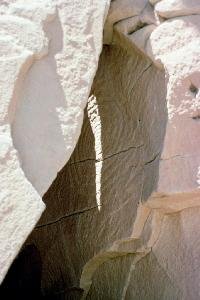
Photo by Paul Charbonneau © High Altitude Observatory, National Center for Atmospheric Research Used with permission |
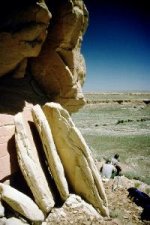
Photo by Paul Charbonneau © HAO/NCAR Used with permission |
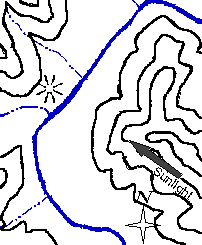
|
Her narrative leads one to expect:
"Look! Look! It's (the sun's rays) hitting the panel," he [Tony Shields]called. A glimmer of pale sunlight struck the sun symbol on the left side of the petroglyph, and the rising sun soon bathed the entire panel in warm sunlight. Shields immediately noticed that the sunlight was funneling through a three-sided notch formed by the rock overhang, the upper left-hand wall of the shelter and a rock shelf that jutted out above the small petroglyph on the lower left wall. A shadow cast by the left wall of the shelter fell to the left of the sun symbol and its adjacent markings. As the group watched, the shadow inched from left to right. Before their eyes, light dawned on West Virginia history.
"That proves it," Shields said pointing to the wall notch. He was the first to realize that Dr. Fell's decipherment never mentioned the horizon. It specified only that a ray of sun would graze the notch on the left side. The ancient scribe was referring to the shelter wall notch!
This most remarkable turn of events served as a reminder that things do not always happen as expected. The group continued to watch as the solar phenomenon demonstrated physical proof of Fell's decipherment.
[...] When Fell heard the news of the winter solstice sunrise, he was greatly encouraged. (Gallagher 1983:9)
| 9:08 - I made this image before the sun had fully emerged from behind the mountain, but could cast enough light to produce a shadow. The rock overhang cast the horizontal shadow, and a tree cast the vertical shadow. Since the tree was about 40 feet away, the edge of its shadow is blurred. |  |
| 9:13 - Five minutes after sunrise, the tree shadow had moved enough to allow the southwest wall to cast its shadow. Note the position of Gallagher's "notch." |
 |
| 9:15 - The shadow from the southwest wall and the overhanging ledge is clear. None of this involves an interaction with the glyphs. |
 |
| 9:28 - Twenty minutes after sun first struck the petroglyph, it was obvious that there would be no alignment. |
 |
| 9:39 - The upper shadow was closing on the sunburst. The southwest wall
of the shelter was still in shadow, but the glyphs on it are visible. Fell
identified these as a Berber (Libyan) text written in an ancient Norse alphabet
called Tifinag (Fell 1983:16; Gallagher 1983:8). Unfortunately, he never published a translation. |
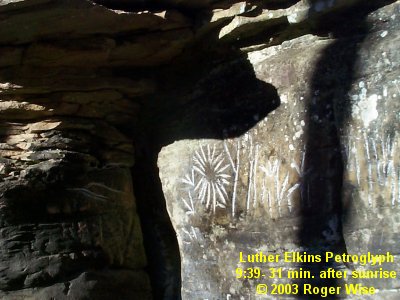 |
|
9:46 - After 38 minutes the overhang's shadow finally touched the top of the sunburst. The tip of the overhang's shadow is touching a patch of lichen, not a glyph. |
 |
| 9:54 - As the shadow from the overhang continued its descent, another tree obscured the vertical shadow thrown by the shelter's southwestern wall. |
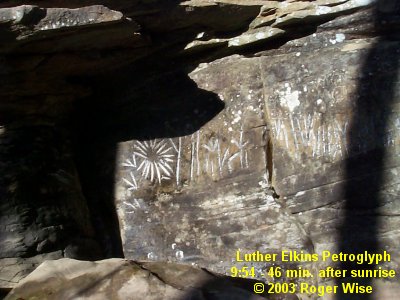 |
| 10:04 - After nearly an hour, the "notch" was clearly not going to intersect with the sunburst, so I abandoned the watch. |
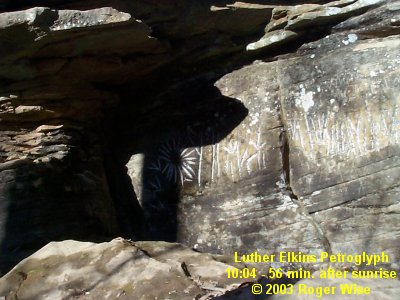 |
CWVA Home Page |
| "Ogham" Introduction Page |
© 2003 CWVA |